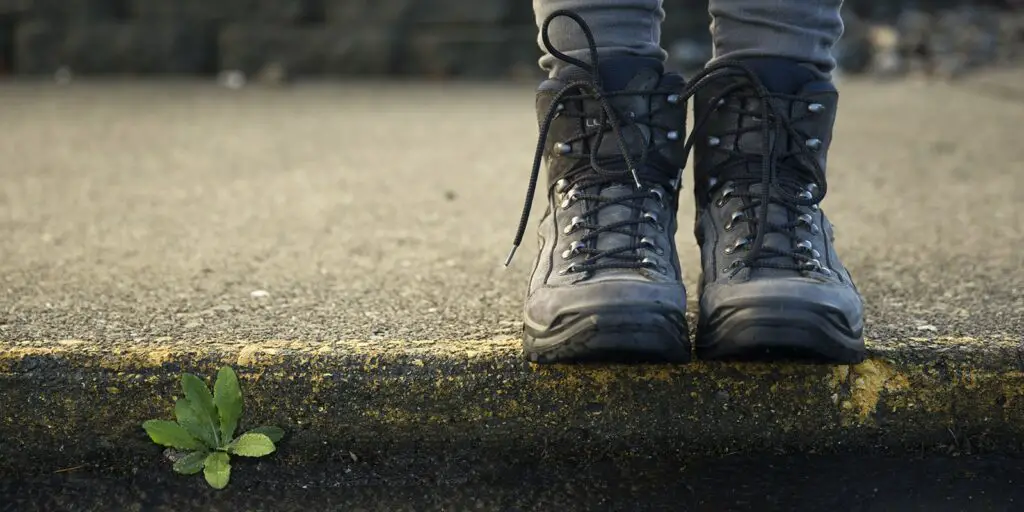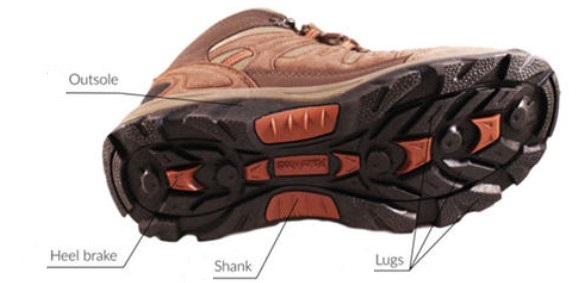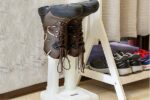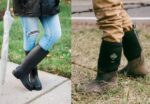Hiking boots are well crafted in a way to fit the hiking purpose. It is not suitable or reasonably accurate for regular walking. Hiking boots or shoes are made of such materials to fit on uneven surfaces and slippery hill ways.
The materials, shape, size, and weight all together contribute to the hiking boots being perfect for hiking, which in turn makes it hard for regular walking.
This doesn’t mean it’s impossible to walk on concrete with hiking boots. But it might affect the real quality of the walking and might wear out the boots quickly.
Let’s see the reasons why hiking boots are not suitable for concrete and what are possible strategies to adapt in terms of walking in concrete.

Why Hiking Shoes Aren’t Good on Concrete
Here are some of the major reasons behind hindering hiking boots on concrete surfaces. Hiking boots will cause stiffness and soreness in your feet after walking for a long time on concrete.
This can cause intense or extreme pain in the ankle area and can lead to tiredness even during a short walk. If you are planning to go for a long walk on concrete with hiking boots, then the probable answer is no!
Walking on concrete can cause hardness in walking and may slow down your pace. You will gradually feel like you are carrying a heavy brick with you. That’s a hyperbole. The real effect will be like you are being pulled down with the heaviness caused by the boots on a regular surface.
Hiking boots are built to walk on through natural terrains and sloppy surfaces. Hence the heels of the hiking boots hold the variant shape and size from regular shoe types or boots. So walking on the pavement with hiking boots is not a good idea.
See also: Best Shoes for Walking on Concrete
Comparison of Hiking Boots & Walking Shoes
As the name suggests hiking boots are designed for hiking and the walking shoes are designed for regular walking.
If any of this is used alternatively, this can cause certain trouble. Let’s see a clear-cut comparison between hiking boots and walking shoes.
Hiking Boots
1.) Purpose
Hiking boots are designed for walking in the wilderness, hilltops, natural terrains, sloppy lands, and places linked with nature where mud, dust, and lots of plants and rocks are present, Thus, it is way more resistant and hard enough in comparison with any other regular shoes.
Normally, people use hiking boots while travelling through forest lands, climbing mountains, and places where an extra grip is necessary.
In such places, if you are planning to go in with regular shoes, either your shoes may wear out or else you may feel extremely tired due to the pulling energy of the shoes. So, hiking boots are a must, if you are planning for an adventure.
2.) Heels & Soles
The hiking boots come in variant designs, where the thick sole type is one of the most common and most used all over. The simple reason behind the thick or heavy boots is to serve the entire purpose of hiking.
If a person intends to walk through a rough surface or an extremely sloppy muddy place, the heavy heels give more grip and resist being more sloppy. Along with that, it enables you to keep firm steps while climbing.
While climbing through hills or walking on uneven land, the common troubles caused by the regular boots are causing pain to the lower foot due to sharp rocks and wooden pieces. Hiking boots are again a blessing when such situations occur. Thus, it is said to be ideal for hiking.

Regarding the sole type, there is no ankle. Mid-height and full ankle boots are available on the market. Each serves its own purpose. No ankle hiking boots are like trail shoes without any ankle support.
These types of hiking boots are perfect for walks over low-land mild forest areas and not ideal for heavy forest adventures. If you are a strong ankle guy and love to feel the real pressure of the land below, this can be used for your personal adventure.
The Mid-height hiking boots are commonly chosen by the majority of the hiking population These boots are supportive and a good choice for people with weaker ankles.
Moderate hiking adventures can be endured with these boots. Whereas, the full ankle boots are ideal for heavy adventures. It provides complete support and handles any route on the journey. No pain can stop you from moving forward with full-ankle hiking boots.
3.) Material
Shoes made from artificial fabrics including solid Cordura fibers are firm, dry fast, and are normally lighter and more adaptable than those with any different type of upper construction.
If you are planning a journey in a hot climate, then you can go for loose women mesh material hiking boots. Leather material can give better durability, strength, and comfort. But, if you are choosing plastic uppers, you can protect yourself from a cold climate with its stiffness and rigidness.
Hiking boots are an excellent choice for hiking trails but have elements that make them an insufficient choice for walking on concrete.
Walking Shoes
1.) Purpose
Walking shoes are generally for long walks or any regular walks. They are softer, milder, and lightweight as compared to hiking boots. As they are regular wear, it is appropriate on concrete pavements.
If you are planning for a forest adventure, better avoid them as they tend to make walking difficult in rocky regions. This can cause ankle pain and stress to the legs.
2.) Heels
As compared to the hiking boots, the regular shoes come in a variety of heel types. Mostly this never comes into a debate, as normal walking can adapt to any heels. But those shoes are never recommended for heavy adventures.
3.) Material
Similar to the heel discussion, the materials for regular walking shoes come in a variety of types. All kinds of synthetic and natural materials are used to make regular shoes and boots.
See also: How to Wear Hiking Boots with Jeans?
What if You have to Use Hiking Boots on Concrete?
No one can say a loud No to hiking shoes on concrete. But always make sure to consider certain facts and ensure caution before moving on.
1.) Hiking boots on concrete will make you uncomfortable. Hence, get another pair of shoes if an extreme discomfort occurs.
2.) Stiffer and heavy hiking boots on the concrete surface will make it heavier to walk. You might feel like lifting yourself with a bit more energy when compared to regular shoes.
3.) It is okay to walk through concrete pavements if it is a short walk. But if it is a long morning or evening walk, consider wearing more comfortable shoes.
4.) If a situation occurs, you can walk on the concrete pavement with low-heel or low-ankle hiking boots. That can be less problematic as compared to the heavy long heeled ones.
5 Tips Before Walking on Concrete
If you are planning to walk on the concrete pavement with hiking boots, then here are some of the tips to consider
1.) Choose a low heel one
2.) Avoid heavy block heels & look for low ankle boots
4.) Avoid using thick materials
5.) Choose as per the weather
Best Hiking Boots
These are some of the top hiking boots used by hiking freaks. If you are planning to go on a hiking journey, be sure to buy a pair of any of these.
These are super comfortable with block heels and ankle support. So, if you are a person with a weaker ankle, hiking boots are a must for you.
1.) Salomon X Ultra 3 Mid GTX
- Waterproof Hiking Boots
- Shaft measures approximately mid-top from arch
- Designed with Descent Control Technology
- Rubber sole
Prices pulled from the Amazon Product Advertising API on:
Product prices and availability are accurate as of the date/time indicated and are subject to change. Any price and availability information displayed on [relevant Amazon Site(s), as applicable] at the time of purchase will apply to the purchase of this product.
2.) Merrell Moab 2 Mid WP
- Waterproof membrane seals out water
- Pigskin leather and mesh upper
- Metal hook traditional lace closure
- Bellows tongue keeps out debris
Prices pulled from the Amazon Product Advertising API on:
Product prices and availability are accurate as of the date/time indicated and are subject to change. Any price and availability information displayed on [relevant Amazon Site(s), as applicable] at the time of purchase will apply to the purchase of this product.
3.) KEEN Targhee III Waterproof Mid
- WATERPROOF
- TRACTION
- SUPPORT
- FIT & COMFORT
- CARE TI
Prices pulled from the Amazon Product Advertising API on:
Product prices and availability are accurate as of the date/time indicated and are subject to change. Any price and availability information displayed on [relevant Amazon Site(s), as applicable] at the time of purchase will apply to the purchase of this product.
Best Shoes for Walking on Concrete
These are some of the best shoes for walking on concrete or hard surfaces. These shoes are made with enough stiffness and grip to hold you on regular walking. Thus, it cannot be used as an alternative for hiking boots.
1.) Skechers Men’s Search Loafer Shoes
- Casual loafer featuring contrast stitching, padded collar
- Dual elastic goring
- Gel-Infused Memory Foam comfort insert
Prices pulled from the Amazon Product Advertising API on:
Product prices and availability are accurate as of the date/time indicated and are subject to change. Any price and availability information displayed on [relevant Amazon Site(s), as applicable] at the time of purchase will apply to the purchase of this product.
2.) Dansko Waterproof Outdoor Sneaker
- Waterproof leather uppers
- Removable triple-density footbed with arch support and shock absorption
- Accommodates most standard and custom orthotics
- DuPont Sorona fiber for moisture management
- CleansportNXT for odor control
Prices pulled from the Amazon Product Advertising API on:
Product prices and availability are accurate as of the date/time indicated and are subject to change. Any price and availability information displayed on [relevant Amazon Site(s), as applicable] at the time of purchase will apply to the purchase of this product.
3.) Skechers Work Sure Track
- Memory foam insole
- Soft fabric shoe lining. Padded collar and tongue
- Closure Type: Lace-Up
Prices pulled from the Amazon Product Advertising API on:
Product prices and availability are accurate as of the date/time indicated and are subject to change. Any price and availability information displayed on [relevant Amazon Site(s), as applicable] at the time of purchase will apply to the purchase of this product.
Next time, if you are planning an adventure trip or hiking, make sure to consider the above factors of ankle support, heels, materials, climate, and so on.
This can give you a better experience than a painful journey. And if you are planning for a regular walk on concrete pavement, forget about the hiking boots, and walk with regular shoes for a happy walk!
FAQs
Are Hiking Shoes Good for Walking on the Concrete Pavement?
Hiking shoes are perfect for forest areas, hilltops, and rocky mountains. But it is okay to choose hiking shoes for walking on concrete pavement, only with caution. It is not good to choose hiking boots for long walks and regular usage on concrete surfaces
Is There a Difference Between Hiking Boots and Work Boots?
Yes, hiking boots are thick and stiff for hiking purposes with a tinge of flexibility in them. The working boots are purposefully created with extra stiffness and firmness to create a protective shield against cuts, falls, injuries and accidents.
Can you Exercise in Hiking Boots?
It is okay to use hiking boots occasionally for walking and running. But talking about the healthier part, it is not recommended for regular usage. If you are planning for a healthy exercise, go for a regular wear or gym wear shoes.
What’s the Difference Between Hiking and Walking?
Hiking shoes are meant for hard, rocky, forest surfaces, while, the walking shoes are meant to be used for regular daily walking purposes.
Hiking shoes tend to have heavier, thicker, and larger with proper ankle support heels and thick materials, whereas, walking shoes have milder versions of these features, like soft or normal materials, variant fashion heels, general support to the ankle or no ankle support
Is it OK to Jog in Hiking Boots?
Long-term usage of hiking boots for jogging is not good. If you are planning for a long walk or jogging as part of your exercise, choosing regular shoes or gym shoes is perfect. Choose hiking boots if you are planning to go on rough terrain and not with the regular roads or lands.













